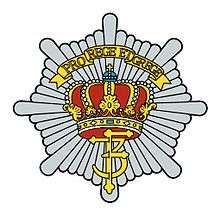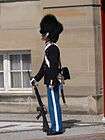Royal Life Guards (Denmark)
| The Danish Royal Guard | |
|---|---|
| Den Kongelige Livgarde | |
 Cap Badge of the Royal Danish Guard | |
| Active | 1658-present |
| Country |
|
| Branch |
|
| Type | Foot Guards |
| Role |
1. Bataljon – Mechanized infantry 2. Bataljon – Mechanized infantry 3. Bataljon – Training |
| Size | Four battalions |
| Part of | Army Staff |
| Garrison/HQ |
I. Bataljon – Garderkasernen, Høvelte II. Bataljon – Garderkasernen, Høvelte III. Bataljon – Garderkasernen, Høvelte Guards Company – Copenhagen |
| Nickname(s) | Livgarden, Garden |
| Motto(s) | Pro Rege et Grege (For King and People) |
| Colors |
|
| Engagements |
Northern Wars Scanian War Great Northern War Napoleonic Wars First War of Schleswig Second War of Schleswig Operation Weserübung War in Afghanistan (2001–2014) Post-invasion Iraq, 2003–2011 Operation Inherent Resolve Resolute Support Mission |
| Commanders | |
| Ceremonial chief | HM Queen Margrethe II of Denmark |
| Colonel of the Regiment | Mads Rahbek |
| Notable commanders |
Duke William of Württemberg Christian X of Denmark Alexander III of Russia |
The Royal Life Guards (Den Kongelige Livgarde) is an infantry regiment of the Danish Army, founded in 1658 by King Frederik III. It serves in two roles: as a front line combat unit, and as a guard/ceremonial unit to the Danish monarchy. Until its disbandment, the Royal Horse Guards (Livgarden til Hest), served the role as the mounted guard/ceremonial unit, afterwards the role was taken over by Guard Hussar Regiment Mounted Squadron. During the time period 1684-1867, the Royal Life Guards were called The Royal Foot Guard (Den Kongelige Livgarde til Fods), in order to distinguish between the regiment and the Royal Horse Guards. During his time in the Danish forces, Crown Prince Frederik served a tour in the Royal Life Guards with the rank of Sergeant.
Guard duties
The Royal Life Guards provide a permanent guard at the Amalienborg Palace, Kastellet (part of the old fortification of Copenhagen), Rosenborg Castle/garrison of the Royal Life Guards in Copenhagen and the garrison of Høvelte. On occasions guard is kept at Fredensborg Palace, Marselisborg Palace, Gråsten Palace, Christiansborg Palace and other locations inside the Danish realm.
Uniform
The ordinary uniform of the Royal Life Guards while they are on guard duty is dark blue. Their full dress uniform is very similar to that of the Foot Guards regiments of the British Army: a scarlet or blue tunic; blue trousers; and a bearskin with the regiment's cap badge (the Sun and Royal Coat of Arms); together with the symbolic infantry sabre, which is part of the spoils from the First Schleswig War 1848–1850 and originally a French infantry sabre.
Organisation
The regiment itself has three battalions and the Guards Company:
- 1st Battalion (I Bataljon) – Founded 1658. Mechanized Infantry Battalion, part of 2nd Brigade.
- 2nd Battalion (II Bataljon) – Founded 1867. Mechanized Infantry Battalion, part of 2nd Brigade.
- 3rd Battalion (III Bataljon) – Founded 1923. Training Battalion.
- Guards Company (Vagtkompagniet) - Founded 1659. Ceremonial/guard unit.
Alliances
-
 United Kingdom – The Princess of Wales's Royal Regiment (Queen's and Royal Hampshires) – Bond of Friendship
United Kingdom – The Princess of Wales's Royal Regiment (Queen's and Royal Hampshires) – Bond of Friendship -
 Germany
Germany
Image gallery
- Royal Guards on Queen Margrethe II's Birthday, 16 April 2009.
 Royal Guard at the Amalienborg Palace, Copenhagen.
Royal Guard at the Amalienborg Palace, Copenhagen. Danish Royal Guards presenting arms at the Changing of the Guard ceremony, Amalienborg.
Danish Royal Guards presenting arms at the Changing of the Guard ceremony, Amalienborg. Royal Life Guards in Frederiksgade, Copenhagen
Royal Life Guards in Frederiksgade, Copenhagen Changing of the Guards at Amalienborg Palace.
Changing of the Guards at Amalienborg Palace..jpg) Royal Guards in Amalienborg Palace, Copenhagen
Royal Guards in Amalienborg Palace, Copenhagen
See also
External links
| Wikimedia Commons has media related to The Royal Life Guards in Denmark. |